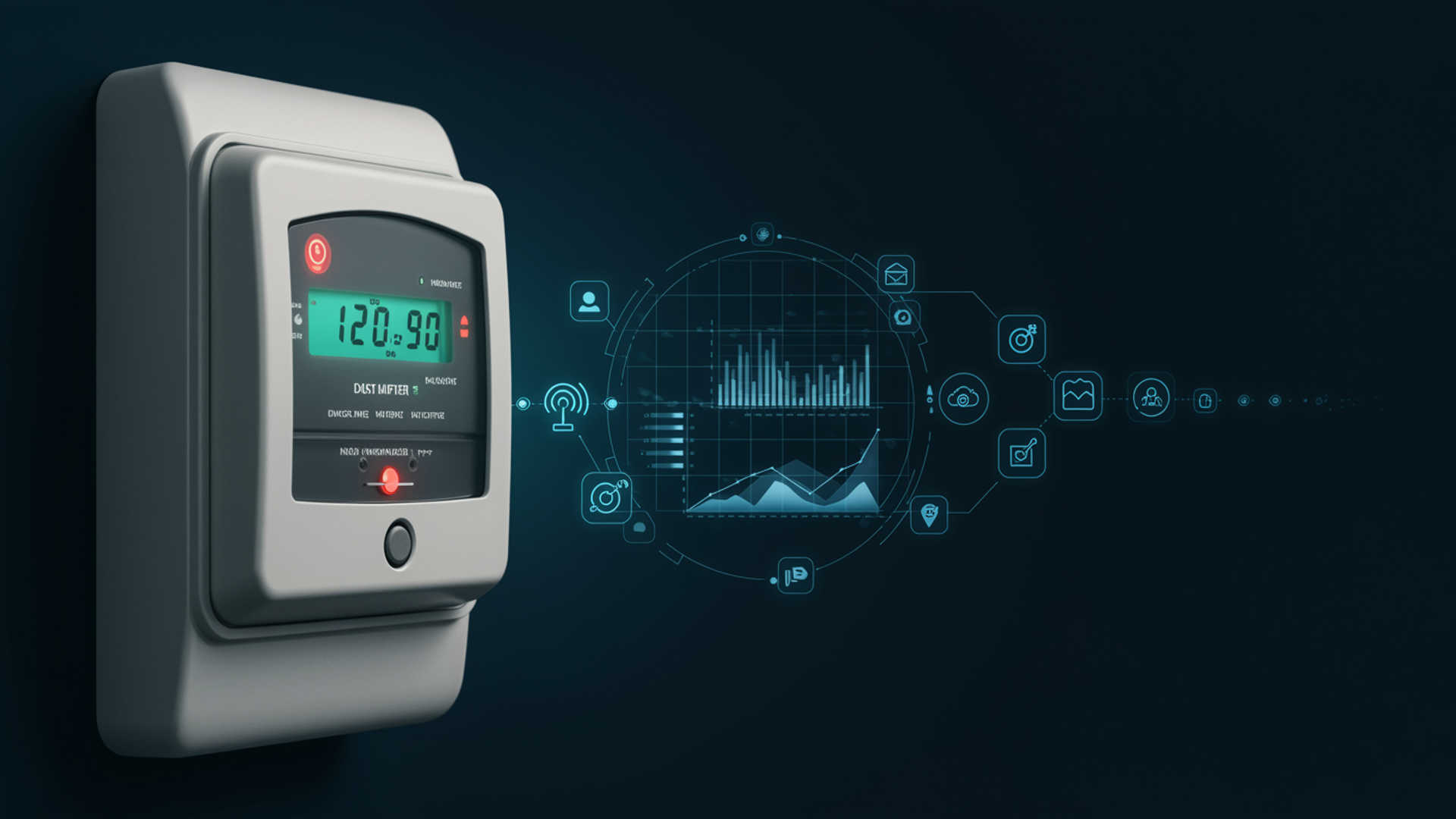Executive Summary: Utility Management Software Has Become a Core Component in Modern Utilities
Modern Utilities are expected to provide more than a reliable, continuous supply of gas, power or water. There is constant pressure to modernize AMI infrastructure, while maintaining cost efficiency, transparency and meeting sustainability goals. These demands have elevated utility management software from a back-office tool to a strategic enabler of operational intelligence.
In the United States, utility leaders are seeking digital core replacements to connect fragmented billing, assets, and workforce systems into platforms that unify data, processes, and performance analytics in real-time. These solutions do not simply digitize workflows, but ensure people, assets, and information work in sync.
Key Industry Trends & Insights:
- Credence Research indicates that the global grid modernization market was valued at $42.6 Billion in 2024. The valuation is expected to reach $158.2 Billion by 2032.
- A study by Fortune Business Insights highlights the global utility asset management market is expected to grow at a CAGR of 4.52% from 2025-2032, reaching a value of $7.29 Billion.
- As per Cognitive Market Research, North America currently holds 38.9% share of the global utility software market.
- According to a report by Accenture ‘Tech Vision 2025’, AI integration in utility infrastructure is redefining how the workforce learns, collaborates and delivers results. Around 80% of US executives anticipate a shift towards focus on more innovation-focused roles, as AI adoption continues.
These results underline a strategic reality:
For utilities’ leaders, their competitive edge will not be derived from acquiring more software. Instead, it will come through the unification of operations, data, and field intelligence around a single management platform.
What Is Utility Management Software, & Why It Matters Now
Utility Management Software (UMS) refers to an integrated enterprise platform that brings together all functions of a utility, from asset and workforce management; to billing, data governance, and customer engagement, all within a single operational framework.
Traditional ERP or MDM systems mostly manage disparate processes. Modern platforms for utility management facilitate bi-directional data flow among systems like the HES, MDM, GIS, or CRM. They act as an intelligent backbone, enabling executives to gain real-time control over field operations, regulatory reporting, and elevate consumer experience.
For US utilities, this convergence of systems becomes crucial for utilities seeking to meet infrastructure modernization goals under initiatives such as DOE and IRA (Inflation Reduction Act) programs.
Importance for utility stakeholders:
- For IT leaders, these solutions ensure data interoperability and scalability.
- For operations executives, they simplify workforce, asset, and outage management via workflows.
- For customer experience and billing teams, utility solutions guarantee transparency and accountability, all throughout the meter-to-cash cycle.
The Utility Digital Shift: From Process Automation to Operational Intelligence
Utilities today have changed their approach from digitizing isolated tasks. Now, the emphasis is more towards attaining operational intelligence. The goal is building a connected intelligence layer that enables real-time operational decision making, with various processes connected by data.
Yes, legacy platforms automated some processes like billing and outage management. However, they often did not exchange data with each other in real time, or with departments and divisions.
As grid modernization efforts are underway around the U.S., utilities are replacing these disconnected tools with connected operational platforms. This is to ensure that thinking and actions are continuously aligned across teams or departments.
This digital shift is not about replacing or adding more software but embedding a unified visibility layer across utility operations. For example, with every action in the field, data would stream directly into command centers. At the same time, updates are sent to supervisors on how changes in work are impacting planning, monitoring, and forecasting.
Utilities generally go through three stages of maturity during their transformation:
Digitization- Automating basic processes such as meter reads, billing, and outage reporting.
Integration- Connecting AMI, GIS, CRM and ERP systems, and eliminating data silos.
Intelligence- Leveraging predictive analytics, and AI to support real-time decision making and improve efficiency.
Around 24% of utility executives expect a significant increase in AI adoption across utility workflows, within the next three years. The goal is to unlock utilities’ operational approach from reactive to proactive, enhancing grid reliability, compliance, and market adaptation.
The bottom line is, utilities are not managing systems anymore. They are managing data ecosystems to drive measurable business performance.
Key Capabilities of Modern Utility Management Software
Modern utility management software brings together data, assets, workforce operations, and customer engagement under a unified intelligence layer. Each module plays a critical role in improving reliability, reducing manual effort, and enhancing transparency. Let’s explore some core features of utility management software:
Unified Data Handling
Legacy systems used to process data in batches. Moreover, the activity didn’t happen in real-time but hours or even days after an event occurred. Today, utility management solutions like Grid are equipped with data warehousing capabilities that can manage data streams in real-time. By investing in such platforms, utilities can eliminate data redundancy and ensure stakeholders have access to up-to-date information.
Predictive Asset Oversight
Previously, asset logging used to happen manually which often led to delays and compliance gaps. New-age utility software supports IoT-enabled monitoring that helps continuous tracking of assets throughout the lifecycle, along with generation of predictive maintenance alerts.
With such insights, leaders can make investment decisions based on data-backed performance insights rather than periodic checks.
Smarter Workforce Management
Field teams used to rely on spreadsheets for sharing information between teams. The process was cumbersome, and data was not reliable since it did not take into account any ongoing updates.
Modern utility workforce management like GridOps offer centralized scheduling, real-time field visibility, and SLA-based automation. With features such as automated tasks and ticket assignment, field teams are able to close workflow loops faster. Additionally, supervisors can also track, and verify tasks through dashboards linked to on-ground mobile apps.
Workflow Automation and Process Control
Manual ticketing and email-based approvals once delayed every process step. Traditionally, utilities spent hours tracking task progress across departments.
Utility automation platforms such as Grid Flow now eliminate that bottleneck with
rule-based workflows that ensure each task automatically reaches the right team.
Supervisors also receive live updates through SLA dashboards, reducing follow-up delays.
For example, approval loops for meter validation or outage response are auto-triggered and escalated based on severity. This ensures that issues that require attention are resolved at the earliest. Users can also set up custom rules on Grid to ensure automated action against events, reducing administrative overhead and improving operational discipline.
Centralized Meter Operations
Many utilities still struggle with aging infrastructure where meter data, events, and commands are managed across separate systems. This fragmentation can impact activities like fault detection and billing accuracy.
Modern utility management platforms come with a Smart Meter Operations Center (SMOC) that brings these layers together. Solutions such as Grid SMOC integrate HES, MDM, analytics dashboards, etc, under one view. Every read, command, and event passes through unified validation in near real time.
Utility stakeholders can monitor data flow, detect anomalies, and trigger corrective actions instantly. This unified control helps utilities maintain data integrity and eliminate errors in audit and billing.
Modern Utility Management Software vs Legacy Systems
Mobility and Field Intelligence - The Core of Modern Utility Software
Utility digital transformations have expanded to field operations as well. For any modern centralized utility software, frontline and mobile apps act as integral components. These apps connect operations in and out of control rooms, contractors, and field teams in real-time.
Field mobility is no longer just nice to have, it is the foundation of operational visibility. With digital apps now connected to central servers and systems, every meter installation, inspection, or repair feeds data instantly into enterprise dashboards.
Key benefits frontline mobility brings to the table:
- Offline functionality: Crews can record data in low-signal zones, or even offline and everything syncs up once they are back online.
- Geo-tagged data capture: Minimizes errors erstwhile associated with manual reporting and improves regulatory traceability.
- Multi-platform access: Web portals, Android, and iOS features to keep stakeholders like contractors and supervisors on the same page.
- Seamless integrations: Frontline apps such as Grid connect directly with HES, MDM, and CRM for on-site meter activation, inventory updates, and validation.
- Configurable workflows: Mobile platforms also come with no-code form builders that let them adjust workflows without calling in developers every time.
Utility management platforms such as Grid combine mobility with real-time analytics and automation. For utilities, this translates to survey digitization, enhanced asset tracking and accelerated QA/QC cycles. In a national rollout project, Grid’s frontline solution enhanced survey efficiency by up to 40% via automated approvals. The utility also reported reduction in inventory losses via live asset tracking & management.
Features to Look Out for in a Utility Management Software
Choosing the right solution for utility operations is not just a technical choice, but also a strategic one. The focus of executives and leaders should be on long-term outcomes; from greater agility, and service reliability to meeting sustainable goals. We have listed below some key criteria to keep in mind when evaluating software for utility management.
Interoperability
The utility software must seamlessly integrate with existing systems (HES, MDM, CRM, GIS, OMS, etc).
Open APIs and data streaming compatibility ensure flexibility and prevent instances of vendor lock-in.
Scalability
Utilities often manage multi-domain networks across networks (electricity, water, and gas).
Scalable platforms can help ensure consistent performance as asset numbers and data volumes continue to grow.
Governance & Compliance
Real-time data validation and audit trails provide transparency and accountability in reporting accuracy.
Utility management platforms should maintain data lineage, as well as adherence to evolving regulations and cyber security standards.
AI Readiness
With intelligent analytics, utilities can ensure proactive approach to anomaly detection, demand forecasting, and predictive maintenance.
The ideal solution should enable AI model integration into existing workflows without the need for a complete overhaul.
Mobility
Field teams need configurable mobile applications that can be used as offline apps, where data syncs as and when connectivity returns.
Secure authentication and real time reporting are key features to ensure faster closures on workflow loops and improve overall accountability.
Security & Data Sovereignty
Modern utility platforms must have capabilities for end to end encryption and role based access to protect sensitive data.
Data residency also must comply with regional frameworks like NERC and ISO 27001 to ensure resilience and trust.
Total Cost of Ownership
Leaders should evaluate flexible licensing models and transparent deployment costs.
Cloud native solutions with modular designs simplify upgrades and reduce overall maintenance costs over the long term.
From Software to Strategic Intelligence
Forward-looking utilities that treat management software as a strategic nerve center, and not a mere departmental tool will gain several advantages:
- Operational continuity: Streamlining of workflows across assets, workforce, and operations.
- Regulatory confidence: Adherence to frameworks, real-time auditability and end-to-end data lineage.
- Customer trust: Enhanced billing accuracy and improvement in service interactions.
The next phase of utility management software is enabling complete integration throughout the network. Platforms that merge data warehousing, automation, field operations, and metering intelligence will enable utilities in achieving greater efficiency and resilience. Solutions built on this model such as Grid represent the shift from managing systems to managing outcomes.
The future belongs to utilities that unify data, people, and operations under one intelligent framework. Connect with our team to learn how you can achieve the same transformation.



.jpg)








